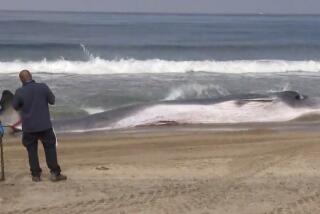75 Dolphins Spotted Off County in First Major Census
- Share via
Volunteer census takers sighted as many as 75 bottlenose dolphins off the coast of Orange County on Saturday, more than were spotted anywhere else during a two-hour count that covered 200 miles of Southern California coastline, from Santa Barbara to the Mexican border.
A total of about 30 of the grayish marine mammals were spotted off Los Angeles, Ventura and Santa Barbara counties. Counters in San Diego County made no sightings. In all, 11 pods--or groupings--of dolphins were seen in the first organized count in the region, more than anyone expected.
“I was thinking that we would see maybe three or four pods,” said Dennis Kelly, a marine biologist at Orange Coast College and a chief organizer of the count. “We saw that number alone in Orange County.
The significance of the large number of local sightings will not be known, Kelly said, until another dolphin census is conducted, probably in August, and compared to the data collected Saturday. A trial count in south Orange County was conducted in November.
Mass Sighting Day
The count Saturday was dubbed Mass Sighting Day, and according to Kelly, was the largest dolphin count ever undertaken anywhere in the world. It covered portions of all of Southern California’s coastline and involved 91 volunteers in Orange County alone.
“We didn’t have the coast thoroughly covered, but we did a pretty damn good job,” Kelly said. “It was like having one continuous eye out there for two hours.”
In addition to learning the size of the dolphin population, Kelly said, the census was designed to collect information on dolphin behavior. The counters, in addition to noting the number of dolphins they saw, also took notes on what they were doing.
Almost nothing is known about the dolphins in Southern California’s waters because researchers for years believed they were migrating and didn’t study them.
Not Migrants
Identification techniques changed that, allowing many animals to be identified as living permanently in the waters of the region, Kelly said.
“It was sort of like finding a herd of buffalo in downtown Los Angeles that nobody knew about before,” he said.
For the Saturday count, Kelly recruited ordinary people, who perched on piers, jetties, cliffs, beaches and road shoulders between 10 a.m. and noon, clutching binoculars and scanning the surf line.
In Orange County, Lynn Redden of Santa Ana said she and her husband, Dave, spotted 12 adult dolphins and two babies in a single pod one hour and 20 minutes after they took up their station at the Santa Ana River jetty. About 45 minutes later, they spotted another pod with 10 adults and what they think was another baby, she said.
“I don’t care how many times I see dolphins, I get a special feeling inside,” said Lynn Redden, who works as a volunteer lecturer on a whale-watching boat. “I was awed by their presence.”
Richard and Roberta Wagner, a couple from Mission Viejo who were stationed at Dana Point Harbor, said they saw a pod of three dolphins speeding past their post.
“It was nice to know we could do something that was fun and scientific at the same time,” said Richard Wagner, a Rockwell International Corp. engineer.
Kelly said he believes the Southern California dolphins are robust, but worries that their diet of about 20 pounds of ocean fish daily may endanger them.
“They are eating fish that have a high level of pollutants and those pollutants become concentrated in a dolphin,” Kelly said.
Once the quality of the dolphins’ health is determined, he said, it will be a litmus test of what humans in Southern California are eating from the ocean.
“If something happens in the environment to knock them off, then we’re in trouble,” Kelly said.
Mass Sighting Day organizers recruited lay volunteers, rather than scientists, he said, because they could cover a large area with little expense and because the experience offered an opportunity to educate them about the dangers that dolphins face.
“We hope they will develop feelings and sensitivities that carry over into their daily lives so these dolphins are protected,” he said.
The data collected Saturday, once analyzed, will be turned over to the volunteers and to officials of the National Marine Fisheries Service, the arm of the federal government responsible for management and protection of dolphins in U.S. waters, Kelly said.
More to Read
Sign up for Essential California
The most important California stories and recommendations in your inbox every morning.
You may occasionally receive promotional content from the Los Angeles Times.










